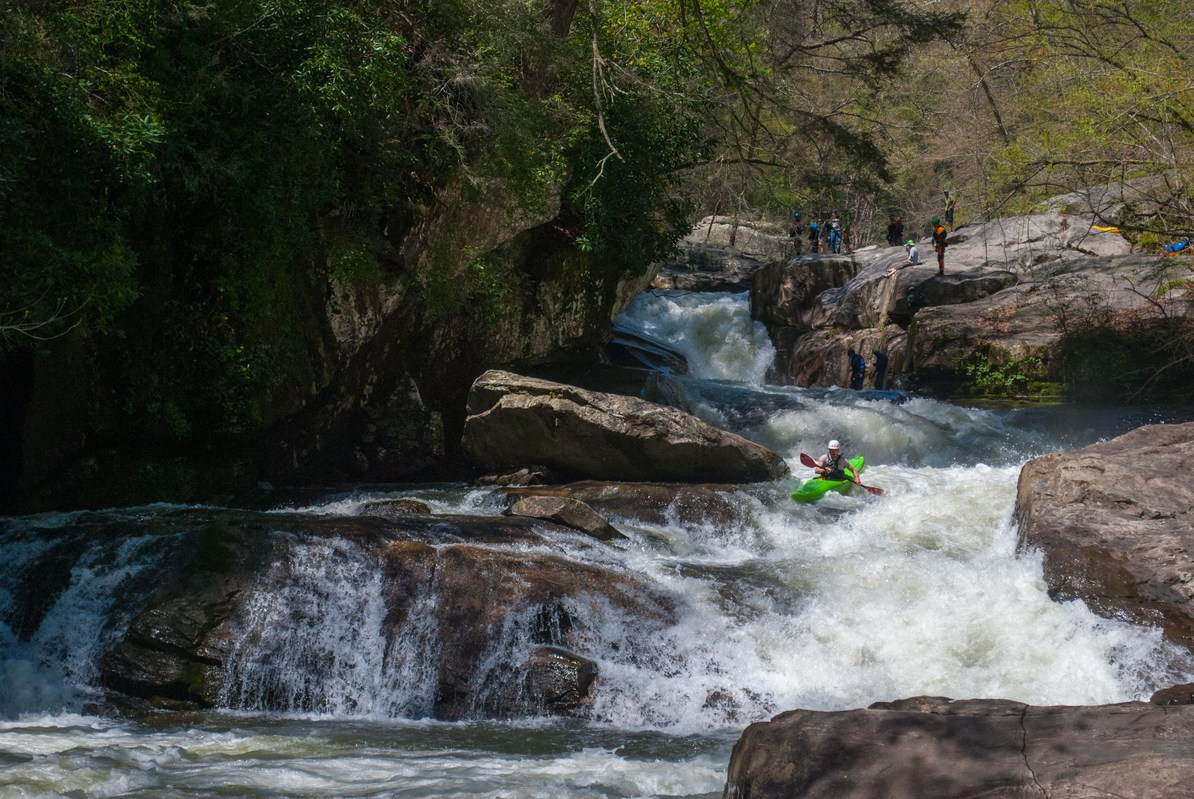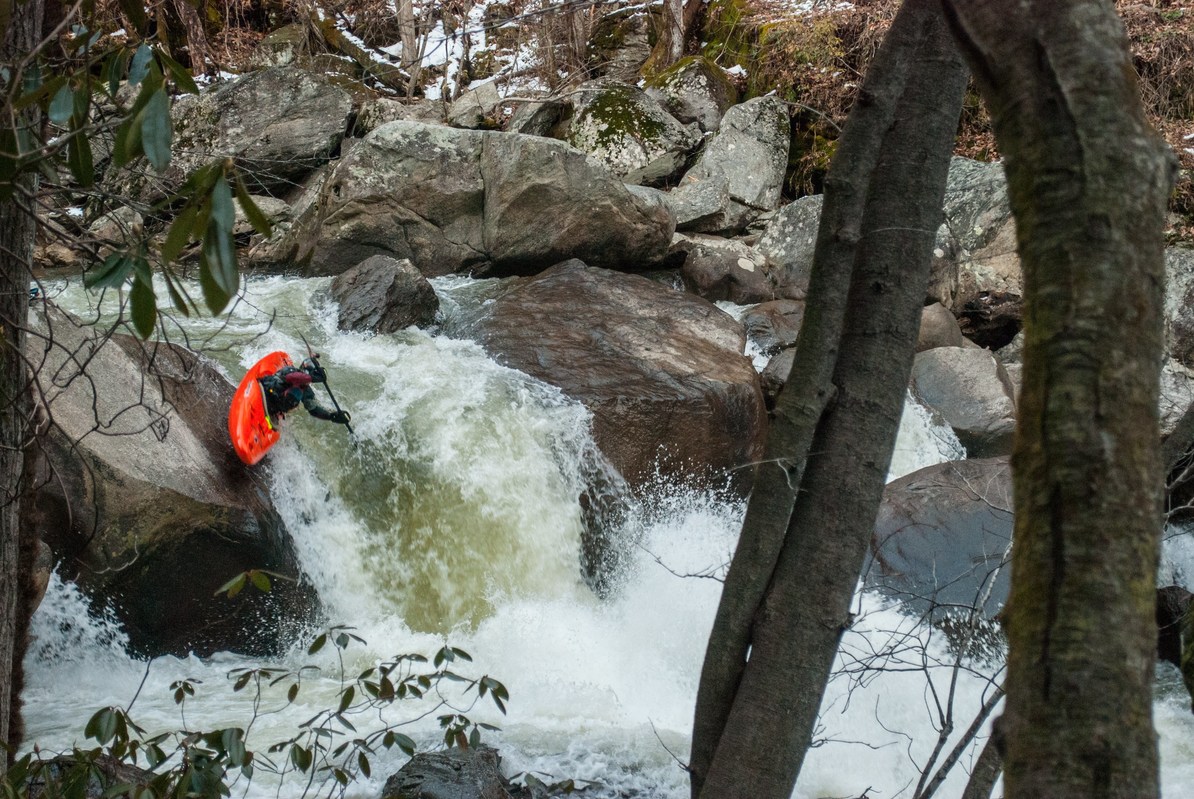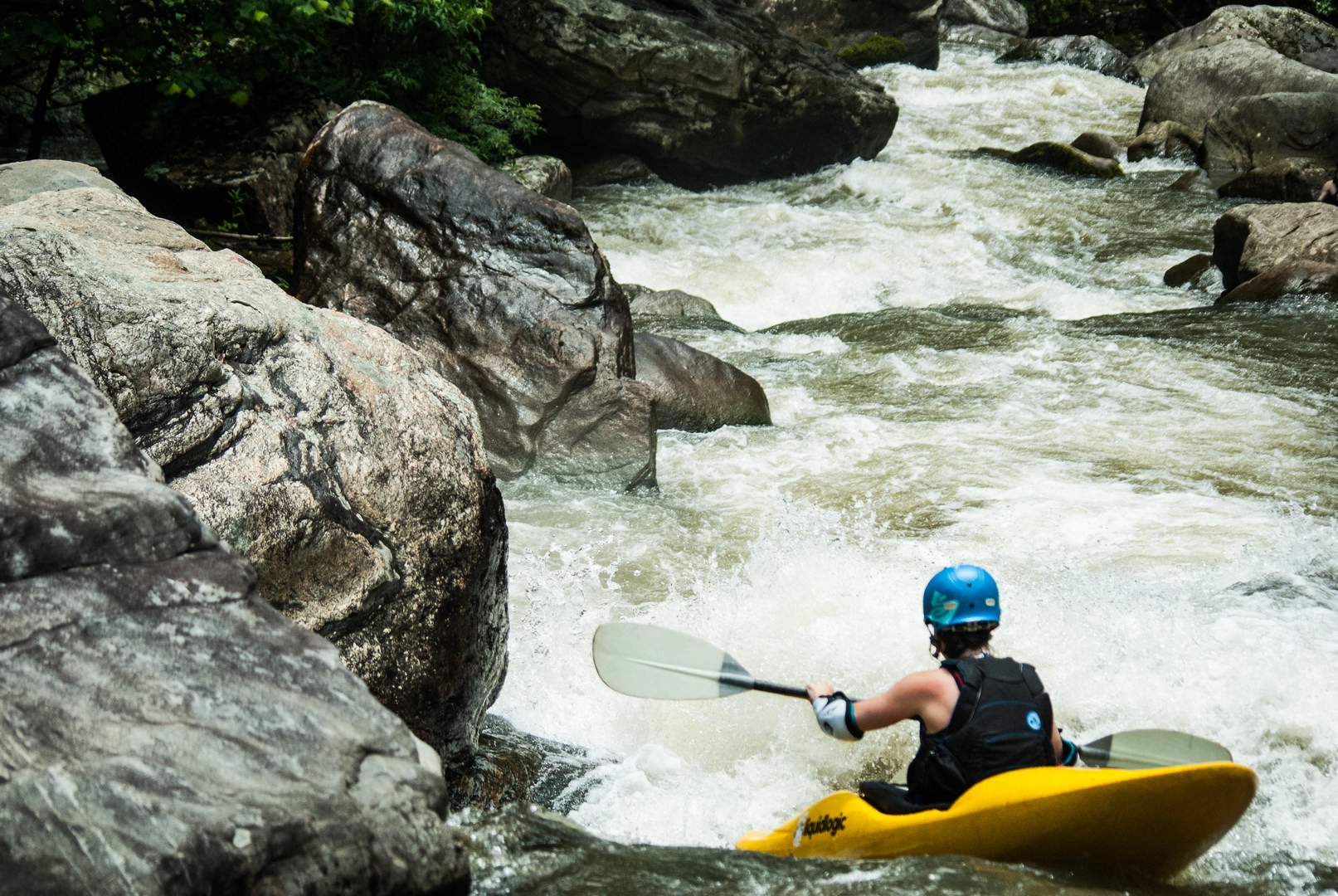You are here
The Green River Narrows might be the most well known Class V River in the United States. Home of the Green River Race, the Green draws in paddlers from all over the world both to hone their skills as extreme racers and to revive the old school playboating phenomenon known as "splatting." Dropping at an average of 178 feet per mile over its 2.88 mile length, the Green is a nonstop, action-packed hairboater's dream: low-volume, pool drop, and jam packed with boulders.
One of the best features of the Green is its reliability. The Green regularly runs as often as 300 days per year due to the dam upstream. Despite this, it retains a wilderness character with a 0.6-mile hike down a trail into a spectacular gorge to reach the put-in. The Green is surrounded by more than 14,000 acres of wildlands known as the Green River Game Lands.
It is also runnable from very low to very high levels: Descents on water levels as low as 6 inches "on the stick" occur regularly in drought conditions, and descents during floods can be as high as 30 inches on the same gage. Typically the dam releases at 100%, roughly equivalent to 7 to 9 inches on the stick. At these flows, many of the rapids are Class IV+, with several Class V rapids. Occasional releases at 200% amp up the difficulty to the Class V-V+ range. With dam releases, the river drops more quickly than it rises, and water takes about 2.5 hours to reach the put-in. When the Green Release Page states a release will occur until midnight, the dam operators won't turn the water off until at least 7 a.m. the following day, leaving ample time for those needing a quick fix to sneak a lap in before work.
In addition to the famous Green River Race held the first Saturday of every November, the green hosts the Jerry's Baddle Bike and Paddle Biathalon each spring, and the Green River Games each September.

Looking back up at the slides below Gorilla. Photo by Eric Adsit.
Paddlers on the Narrows will enjoy a 0.6-mile hike to warm up as they approach the put-in. The trail is well worn, obvious, and for the most part well maintained. The put-in is an excellent embodiment of "the calm before the storm," featuring an idyllic stream rippling beneath a canopy of rhododendron. Several no-name Class II rapids start out the run, flowing past the occasionally-run Big Hungry Creek, the "Stick Gauge" used to measure the flow of the river including tributaries, and toward the first rapid: Bride of Frankenstein (Class IV).
"Bride," as it is often referred to, is an abrupt chute where the river begins its steep descent through the narrows. Two flake rocks make up the main obstacles in this rapid, and they are generally avoided by paddling between them, or all the way to the left. A secondary drop hosts a minor hole that has become popular amongst those who "play" their way down the green.
Immediately after Bride, Frankenstein (Class V) begins. With a convoluted entrance and multiple undercuts, it's no wonder this drop receives a Class V rating despite being relatively easy once you know the line. Scout from the left or right and find the line driving center to right before boofing toward the left above an intimidating (although benign) undercut rock on the right.
A 6-foot drop (Class III) with several lines follows, as well as some boogie water before Pincushion (Class IV). As the name implies, there is some pinning hazard on this drop. Begin on the left, snaking around a large boulder, before driving far to the right to avoid the flaky pin rock.
More boogie water (Class III) follows before Whale Tail (Class III), a shallow and short slide with a severe undercut cave on far river left. Run the slide center or toward the right.
Boof Or Consequence (Class IV+) follows shortly after, with two commonly run lines. The classic line follows the flow straight down the center through a tiny pinch before cutting hard to the right over a 4-foot ledge and then left over another 3-foot ledge with an undercut on the left and a pin spot on the right.
The sneak begins on river right, requiring a precise boof to avoid a nasty pin.
Go Left and Die (Class V+) begins just below Boof or Consequence. One of "The Big Three," Go Left is a common portage or sneak. Scout and Portage from the left, but keep in mind the sneak option on the right. Typically one enters Go Left from far river right to avoid the dangerous log strainer partway through the drop. After sliding down a narrow slot, those "Going Left" will drive hard to the left, boofing the corner of the log and carrying momentum from right to left to make it through a hole and into a painfully narrow slot. While paddlers occasionally make it through the right slot, more often they get beatdown in the hole and swim. When in doubt, hug the middle rock... numerous injuries have occurred when people flip hard to the left as they enter the slot.
For the sneak, paddlers will begin the same way, down the right at the top. They will then continue to the right through a narrow slot into a tiny pool and over a 10-foot slide.
Reverse Seven Foot (Class IV) begins in the runout of Go Left. Here the main flow makes an abrupt turn to the right over an approximately 5-foot ledge. Boof and land in control, because Zwick's Backender (Class V) follows immediately. Scout both from river right above Reverse Seven Foot. Zwick's has a stout hole to boof at the top with a piton rock on the right where most people want to go. Stick to the right if possible, bouncing down a slide. If pushed left, boof as the low angle slide becomes vertical to avoid the undercut cave on the right side of the left channel. Eddy out quickly on the right in the large (but moving!) pool to prepare for Chief.
Chief (Class V) is roughly 30 feet below the runout of Zwicks. Despite its straight forward appearance, Chief is a very dangerous rapid and the source of the Green's first paddling fatality. Portage and scout from the left. The usual line is to run the first of two ledges in the center with right angle. Then continue driving right over the second drop to stay as close to the right hand rocks as possible, with only a slight right angle. The pin rock is in the second drop and is very dangerous.
Less than 100 feet downstream the Gorilla Sequence (Class V+) begins.
Realistically one rapid, the Gorilla Sequence can be divided into three basic sections, all of which can be scouted and portaged from river left. First is the Pencil Sharpener (Class IV+), an approximately 8-foot ledge with a variety of lines. The most common is the extreme right or left, and both require good boofs. The centerline is the most precise, and it lands between two large boulders. It is possible to catch a micro eddy on the left or a large eddy on the right before entering The Notch.
Placed anywhere else on any other river, The Notch (Class V) would be a Class III move. Since it's immediately above Gorilla, it holds a little more weight. In fact, it's the most difficult part of the whole sequence. The entire flow of the river funnels into a slot narrow enough to jump over, with a boiling eddy and an undercut wall on far river right. There is an eddy below The Notch and above Gorilla, but for many people, it's a toss up as to whether you catch it or go directly over the 18-foot waterfall below.
If the Green is the most well known Class V river in the U.S., Gorilla (Class V+) is the reason. Dishing out unbelievable carnage, an incredible aesthetic beauty, and one of the most challenging lines to dial in consistently, it is an icon in the sport. The entire river funnels into a narrow micro-chasm, where it drops over a ramping pad and through 18 feet of space before colliding abruptly with slanted bedrock. Here it is funneled further into the chasm where the violently crashing water speeding over the bedrock meets the deeper water in the pool below, forming the Speed Trap, a notoriously sticky hole with a recirculating eddy on the left. For those that can visualize the line through the sequence and bring it to reality, the Gorilla sequence will be a dream come true.
If Gorilla is a bit too much to chew on, don't worry, the action continues downstream. With an optional seal launch with a shallow landing beginning just below the Speed Trap, paddlers can put-in just above the lowest consequence but most fun section of the Gorilla Sequence. Back to back slides, Scream Machine (Class V) and Nies' Pieces (Class V) continue the sequence dropping roughly 30 feet, with a major hole at the bottom of each. Both can be run left or right.
Another big slide, Powerslide (Class IV+) continues the fun, dropping another 30 feet, with a large hole in the center at the bottom. Drive right at the top to avoid it.
The last of the major slides is Rapid Transit (Class IV+), which drops about 20 feet over a broken slide. Stay center with some right momentum to avoid the undercut wall on the left, but not so far right that you bounce into the crack along the wall on the right.
Below Rapid Transit the riverbed fans out between hundreds of boulders, requiring a tedious but short portage to reach Groove Tube and Sunshine below. If you already know you will be portaging both of these rapids, head to river right. But if you want to run Groove Tube and consider Sunshine, stick to the left.
Groove Tube (Class V) is a 10-foot boof most commonly run down the left side right next to a piton flake that causes a curling roostertail that gives the rapid its name. Keep your bow up, as the landing is shallow in places. Another line down the middle of the drop provides an auto-boof.
Sunshine (Class V+) follows quickly after groove tube, with just a few small eddies separating the two. Eddy out on the right to get out and scout or portage. Sunshine is a more than 14-foot drop onto a flat rock with tiny margins on the extreme right and left for paddlers to land in. It is one of the hardest and most consequential rapids on the Green, having paralyzed at least one paddler. The portage is on the right.
Over the next mile, there are nearly a dozen rapids of lesser difficulty. They are all read and run, with only a few having suggested lines. They are relatively indistinct, but caution should be used as many have significant sieves. When in doubt, scout.
At mile 2.5 the river steepens for one last hurrah at Toilet Bowl and Hammer Factor. Toilet Bowl (Class IV) is a long boulder garden that steepens toward the end. A large tongue of water banks on the right shore and feeds into a beefy hole. Boof here. Several eddies follow before Hammer Factor, but most are small.
Hammer Factor (Class V) drops about 12 feet over a slide directly into an undercut. Fortunately it's harmless, although the hole at the bottom can dish out carnage, especially as the water rises. Hammer Factor is typically run starting center and driving as far left as possible.
All that's left is a few hundred yards of manky Class II until you reach the takeout on river right. A short trail leads to the Fish Top Parking Area.

Running Sunshine to the right. Photo by Eric Adsit.
A note on access: The Green Narrows lie deep within a river gorge and, aside from the put-in and take-out, there are no easy access points in the case of an emergency. The one place where a trail leads directly to the river is on river left at Groove Tube. The trail climbs very steeply for 150 yards before coming to a T with the Pulliam Creek Trail. Turning left, there will be a 2-mile uphill walk to the Big Hungry Road. Following the road to the left will return you to more populated areas.
If there's one downfall to the Narrows, it's the elaborate shuttle. The take-out is at the bottom of a tortuous set of switchbacks popular with masochistic road bikers. The typical put-in requires a "green key" purchased through the Green River Access Fund, a way to ensure access in the future. The shuttle is anything but direct.
From the take-out, return up the switchbacks on the Green River Cove Road, then turn right, and right again onto I-26 N. Take your second exit, Exit 53, and turn right on Upward Road. Turn right on Big Hungry Road, bearing left at the fork to continue on Big Hungry. Take the next right to continue on Big Hungry. Turn right on Gallimore Road and follow until you reach the gated Green River Access Lot. You will need a "Green Key" ($60 via Green River Access Fund) to enter the lot. From here, it is a 0.6-mile hike down a gradual trail to the put-in of the Narrows.
Logistics + Planning
Current Weather: Powered by Dark Sky
























Comments
Sign In and share them.